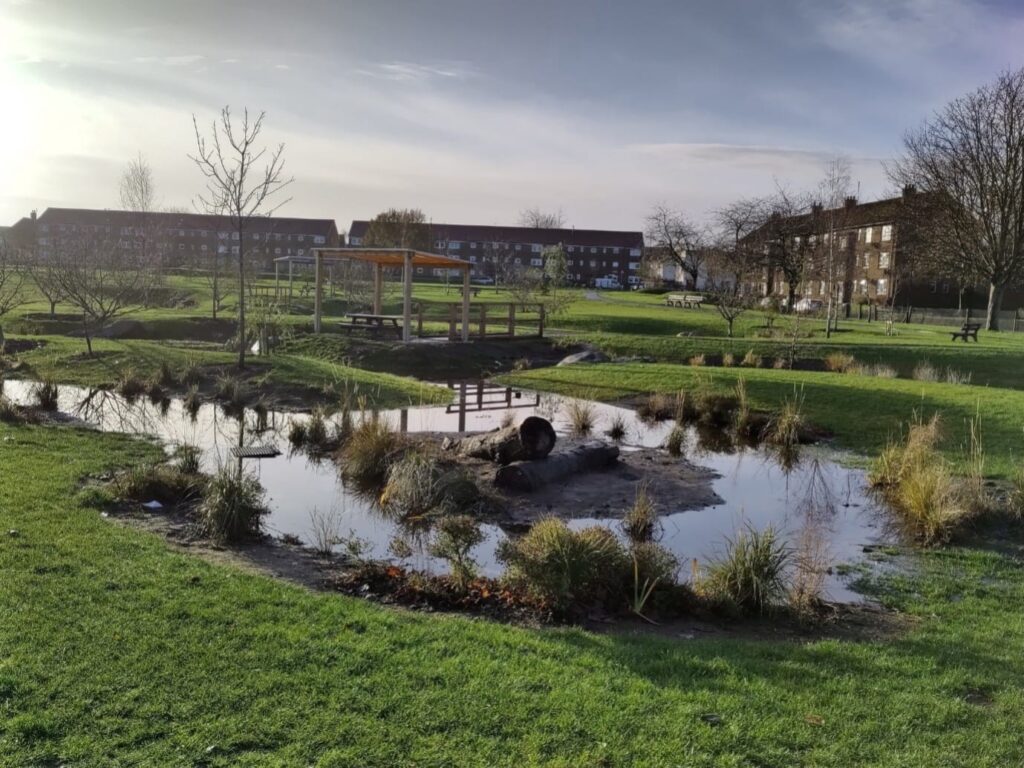GROWING SCOTLAND’S
NATURAL CAPITAL
Scottish Water owns more than 22,500 hectares of land, the equivalent of around 15,000 football pitches.
At the moment we do not know how much carbon dioxide is stored by our land, but will work with the world renowned James Hutton Institute to understand how we best use our valuable natural resources.
CURRENT POSITION
OF LAND OWNED
BY SCOTTISH WATER

INCREASE CARBON
DIOXIDE STORAGE ON
THE LAND WE OWN
INCREASE
BIODIVERSITY ON THE
LAND WE OWN
STORE MORE
EMISSIONS THAN
WE PRODUCE
INCREASE CARBON
DIOXIDE STORAGE ON
THE LAND WE OWN
INCREASE
BIODIVERSITY ON THE
LAND WE OWN
These tables illustrate the key activities we
are exploring to support a flourishing Scotland.
We will keep these under review
with our expert advisory panel.
These tables illustrate the
key activities we are
exploring to support a
flourishing Scotland.

UP TO
2025
• Establish how much carbon dioxide our land stores each year and the biodiversity status of our land.
UP TO
2030
• We show net gain in biodiversity and carbon storage.
UP TO
2040
• Net carbon storage balances or exceeds our ongoing emissions.
• Develop an accredited scheme for annual reporting of nature based carbon dioxide capture.
• Reporting of carbon dioxide capture shows our progress to net zero.
• We work with James Hutton Institute to confirm carbon storage needs and opportunities to deliver and go beyond net zero.
• Complete peatland restoration
on our land and water catchments.
• Sustainable peatland management to lock up carbon dioxide.
• Assess and implement peatland restoration on our land and water catchment in partnership with NatureScot.
• Woodland creation programmes on our land and at operational sites.
• Sustainable woodland management on our land and at operational sites.
• Identify, assess and implement woodland creation on our land and at operational sites in partnership with Forest & Land Scotland and NGOs.
• Implement natural solutions to increase carbon dioxide capture and biodiversity.
• Natural solutions widely adopted to increase carbon dioxide capture and biodiversity.
• Work with partners on grant applications for tree planting and peatland restoration.
• Implement sequestration and biodiversity benefits of urban blue green solutions.
• Transformed blue green urban landscapes.
• Investment options adopt natural solutions to increase carbon dioxide capture and biodiversity (eg water catchment management for water quality).
• Demonstrate and implement carbon dioxide capture and biodiversity benefits of urban blue green solutions

UP TO
2025
• Establish how much carbon dioxide our land stores each year and the biodiversity status of our land.
UP TO
2030
• We show net gain in biodiversity and carbon storage.
UP TO
2040
• Net carbon storage balances or exceeds our ongoing emissions.
• Develop an accredited scheme for annual reporting of nature based carbon dioxide capture.
• Reporting of carbon dioxide capture shows our progress to net zero.
• We work with James Hutton Institute to confirm carbon storage needs and opportunities to deliver and go beyond net zero.
• Complete peatland restoration
on our land and water catchments.
• Sustainable peatland management to lock up carbon dioxide.
• Assess and implement peatland restoration on our land and water catchment in partnership with NatureScot.
• Woodland creation programmes on our land and at operational sites.
• Sustainable woodland management on our land and at operational sites.
• Identify, assess and implement woodland creation on our land and at operational sites in partnership with Forest & Land Scotland and NGOs.
• Implement natural solutions to increase carbon dioxide capture and biodiversity.
• Natural solutions widely adopted to increase carbon dioxide capture and biodiversity.
• Work with partners on grant applications for tree planting and peatland restoration.
• Implement sequestration and biodiversity benefits of urban blue green solutions.
• Transformed blue green urban landscapes.
• Investment options adopt natural solutions to increase carbon dioxide capture and biodiversity (eg water catchment management for water quality).
• Demonstrate and implement carbon dioxide capture and biodiversity benefits of urban blue green solutions

UP TO
2025
• Establish how much carbon dioxide our land stores each year and the biodiversity status of our land.
• Develop an accredited scheme for annual reporting of nature based carbon dioxide capture.
• We work with James Hutton Institute to confirm carbon storage needs and opportunities to deliver and go beyond net zero.
• Assess and implement peatland restoration on our land and water catchment in partnership with NatureScot.
• Identify, assess and implement woodland creation on our land and at operational sites in partnership with Forest & Land Scotland and NGOs.
• Work with partners on grant applications for tree planting and peatland restoration.
• Investment options adopt natural solutions to increase carbon dioxide capture and biodiversity (eg water catchment management for water quality).
• Demonstrate and implement carbon dioxide capture and biodiversity benefits of urban blue green solutions
UP TO
2030
• We show net gain in biodiversity and carbon storage.
• Reporting of carbon dioxide capture shows our progress to net zero.
• Complete peatland restoration on our land and water catchments.
• Woodland creation programmes on our land and at operational sites.
• Implement natural solutions to increase carbon dioxide capture and biodiversity.
• Implement sequestration and biodiversity benefits of urban blue green solutions.
UP TO
2040
• Net carbon storage balances or exceeds our ongoing emissions.
• Sustainable peatland management to lock up carbon dioxide.
• Sustainable woodland management on our land and at operational sites.
• Natural solutions widely adopted to increase carbon dioxide capture and biodiversity.
• Transformed blue green urban landscapes.
KEY ENABLERS
TO SUPPORT NET ZERO EMISSIONS
expanding land management and biodiversity skills
of multiple benefits of nature based solutions
Seeking grant funding to accelerate projects
KEY ENABLERS
TO SUPPORT NET ZERO EMISSIONS
expanding land management and biodiversity skills
of multiple benefits of nature based solutions
Seeking grant funding to accelerate projects
EXTERNAL FACTORS TO SUPPORT
NET ZERO EMISSIONS
SCIENTIFIC
UNDERSTANDING
how we account for
carbon dioxide storage
EXTERNAL FACTORS TO SUPPORT
NET ZERO EMISSIONS
how we account for
carbon dioxide storage
SUPPORTING
EMERGING GREEN TECHNOLOGY
Decarbonising heating and transport are two big challenges for Scotland to deliver net zero.
Scottish Water is working to support these challenges through two activities – the availability of renewable heat from sewers using heat pumps and in supporting the hydrogen economy, which is forecast to have a role in decarbonising both heat and transport. These will be crtitical in our support of the green recovery.
SUPPORTING THE
HYDROGEN ECONOMY
The production of hydrogen needs a lot of water and we want to work with partners to understand the implications for Scotland’s water resources.
We will play our part in developing integrated water and energy systems to enable the hydrogen and renewable economy.
WHAT WE COULD
USE HYDROGEN FOR
FUEL FOR COMMERCIAL
VEHICLES/HGV
WASTEWATER
SLUDGE PROCESSING
HEATING BUILDINGS
EXPANDING HEAT
FROM SEWERS
Scottish Water pioneered recovering heat from sewers in the UK.
We have delivered 2 schemes which are saving over 300 tCO2e pa, and are commissioning a further scheme with even greater potential. We are undertaking feasibility studies at other sites to increase use of this renewable heat source.
Scottish Water has established a framework for the supply of sustainably sourced hydrotreated vegetable oil that can be used by both Scottish Water and its construction partners. It’s a drop in fuel replacement that reduces emissions by 90% compared to conventional diesel.
Over the last year it has been widely adopted by our construction partners, displacing diesel use in excavators, cranes and other heavy plant. It is also being used to fuel generators to provide power for remote construction sites.
On our water mains rehabilitation programme its adoption is expected to reduce emissions by nearly 30%.
Scottish Water has been a partner in a project, led by the local community and supported by the National Lottery’s Community Fund, to regenerate the site once occupied by Douglas Primary School as a multi-functional greenspace.
Our team worked with the community to incorporate sustainable drainage features in the new park, which store and slowly release the rainwater that falls on surrounding roads and rooftops during storms. This eases pressure on the combined sewer network in the local area, as well as helping to protect the local environment and reduce flood risk from the Dighty Burn. Importantly, the community has been able to realise its wider aims by creating an attractive outdoor space that also provides a home for wildlife; and can be enjoyed for play, relaxation, exercise, events and the growing of food.

Planning is now underway to introduce more sustainable water management measures in the area surrounding the park, with the aim of disconnecting over 40,000m2 of land area from the combined sewer network; and helping to enable the development of more social housing in Douglas. Engagement with the community, including schools and other key stakeholders, is being carried out to help shape the proposals.
Work with the community and Dundee City Council on sustainable drainage for Douglas has helped to inspire the Water Resilient Dundee partnership. This initiative is now pursuing opportunities for more sustainable management of stormwater across the city, reducing flood risk in communities, creating capacity for development and enhancing amenity.